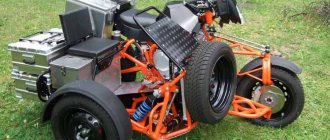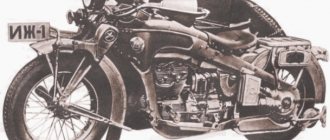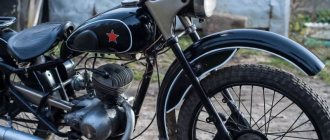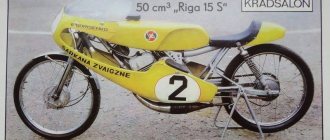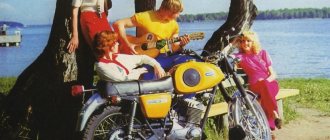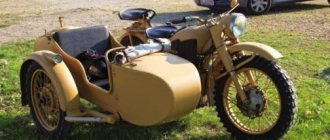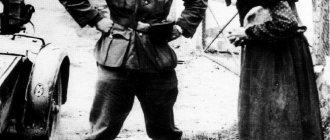General data M-52
Motorcycle type - single (with sidecar). Wheelbase, mm - 1435. Ground clearance, mm - 125. Track, mm - 1100.
Dimensions, mm: — length — 2160; — width — 760; — height (according to the ignition key) — 1000.
Motorcycle weight, kg: — dry — 185; - worker - 200.
Fuel consumption on the highway, l/100 km - 4.5 (6.0). Fuel range on the highway, km - 400 (300). Maximum speed, km/h – 120 (100).
Capacity (oil), l: - engine crankcase - 2.0; — gearbox housing — 0.8; — reverse gear housing — 0.150; — air purifier — 0.2; — fuel tank capacity, l — 18.
Having successfully sold my first Ural motorcycle in 2009, I remained on foot. I still attended garage parties, but looking at my friends’ equipment I became increasingly depressed. It is impossible to describe when the world becomes gray and boring, every new breath of air no longer brings joy. I became seriously ill and even the beautiful half of humanity did not invigorate me with their existence. From time to time I began to help friends with equipment, because at that time my hands were best suited for boxers. I distilled, adjusted the ignition, adjusted carburetors and valves, and did not refuse anyone. Little by little, joys began to appear. Namely, they remembered the blooming candle frame, which has been moving from cellar to cellar for many years. After a while, a reserve power unit and gearbox were dug out of the stash. There were always plenty of wheels in the garage - Urals everyone loved it, they didn’t grieve about the wiring either. I exchanged the tank a little, although without the glove compartment lid, borrowed the front fork from a friend’s stash =) In the fall of 2009, an ugly (even terrible) duckling was settled in the garage with my own hands. Every day, when I came home from work, I surfed Rattbike sites and communities, looking for a good layout and style that would fit well with my scrap metal. I managed to ride my “hardware” a couple of times. For the first time I discovered the delights of a spark plug suspension, and although there were no brakes yet, only two working gears, 1st and 4th, did not allow me to accelerate very quickly, but anyone who has driven it knows that it’s possible. However, after some time, my views changed along with the rear wing-gate that appeared, identical wheels were immediately found, my head was full of ideas. Since the opportunity turned up, a sketch of the future bike was quickly re-planned in my head. The idea became to get as close as possible to the retro original. Somewhere I noticed a front fender with a wide hem and immediately took it out. The winter passed with little troubles, the gearbox was successfully replaced with a fresh one, the front fork was also freshened. The 2010 season was approaching, my head was exploding - I won’t make it in time, I won’t be able to, I don’t know how to paint... That’s it, friends and friends who will always help. 20 km from my city, there is another one, a great guy lives there, with hands and ideas from God, sometimes embodying the most unimaginable fantasies. It was he who was my salvation. Having collected my belongings and upcoming plans in the form of a pile of weighted iron from a motorcycle, I took a taxi to the savior’s lair. With serious instruction, I was taught to carefully rub down the ribs and roundness of the parts after putty. A couple of times I painted the parts with some kind of “indicator”. From work, my fingers went numb and swollen. For two days I was tormented by thoughts like: “I wanted a rattbike, well, what... I got carried away.” The mentor’s words constantly sounded in an orderly tone: “I won’t let you out of my workshop with jambs, handle it better, go through it more carefully... My hands they didn’t obey, in those places where I seemed to have worked the surface perfectly, my mentor somehow unimaginably found the smallest erases or imperfections. The result was worth it
Now I had to decide on the color. Initially I wanted khaki, but after hearing a lot about the qualities of mixtures of this color, I changed my mind. I was advised classic black. Well, let's start painting. After painting, all the parts went through a “bathhouse”. They gave the paintwork heat. At home I kept the parts under a white sheet while I worked on finishing the engine and brakes, which were not there until the last moment. I read BikePost with special love, I want you all to experience the same thing, or at least approximately. I have enough materials for the first time of the off-season, since the start of a new one is soon, I am in a hurry to upload everything that was in the archives. Well, now you can inspect the result of this painting and the first version of the style of the motorcycle, which I sweated the most in my life. How gorgeously the sky was reflected in the depths of the details... I felt the wildest delight from the work done. The motorcycle was like this for half a season. Somehow, by chance, my hands happened to disassemble for parts m72, from which I was lucky enough to keep the trophy steering wheel. By this time I had already replaced the wheels with completely new ones, with fresh tires, on which all the antennae remained intact, installed an oblique step, which they made for me from the rear axle of 8.103.10. On this bike I I received my category “A” license, and successfully ended the season with a 350-kilometer raid in neighboring cities and friends, and there were also walks in the forest. This is how the motorcycle remained in my memory. Unfortunately, it is no longer there, it was dismantled into parts in all directions. The frame is in the possession of a military reconstruction club, the steering wheel is also there, the engine is in reserve in the garage, the wheels ride on another Urals. But the soul of this motorcycle lives in me, no matter how snotty it may sound. Throughout its history, I realized that the Newtonian system of degeneration of forces does not work correctly, at least in my understanding of the world.
Engine
Engine type: four-stroke two-cylinder. Brand - M-52. Cylinder diameter, mm - 68. Piston stroke, mm - 68. Working volume, cm cubed - 494. Compression ratio - 6.2±0.2. Maximum power, l. With. — 24. Maximum torque, km — 3.25. The block head material is aluminum alloy. The head gasket is asbestos metal 0.6 mm. The piston material is aluminum alloy.
Valve distribution phases (according to the angle of rotation of the crank), degrees: - beginning of intake to c. m.t. - 57; - end of intake after n. m.t. - 77; - beginning of release BC m.t. - 97; - end of release after c. m.t. - 37.
Carburetor - two K-52.
M-52S
This entry is also available in: English Chinese
[/container] [/content_band]
Motoryriada No. 45 IMZ M52-S
Test drive video
In the early 50s, the Central Design Bureau of Motorcycle Manufacturing in Serpukhov was tasked with carrying out design and research work with the goal of creating two types of road motorcycles with boxer engines with a displacement of 500 cc. cm, unified with the then mass-produced M-72. Two motorcycle factories that made the M-72 were also involved in the work - Irbit and Kiev. Moreover, at IMZ it was decided to launch the “five hundred”, as unified as possible with the M-72, into production, and at KMZ - a completely new car.
In 1954, the first experimental M-52 with an engine designed by the Central Design Bureau was built at IMZ. The best way to read about the features of this new overhead valve engine is in the TsKB report: “The engine is made on the basis of maximum use of M-72 engine parts, for example, a serial crankcase was used with minor changes in the last machining operations. The diameters of the crankshaft journals, piston pin and rollers with cages remain unified with the corresponding parts of the M-72 engine. The rod gas distribution mechanism is borrowed from repeatedly tested designs and is almost completely similar to the design used on the latest model of the BMW R-51/3 road motorcycle, at the same time it has some technological advantages in the conditions of IMZ production. The cylinders are cast from aluminum alloy and have pressed cast iron liners...”
In 1957, production began of a sports modification of the M-52 - M-52S for road racing. Basically, it was the chassis of the latest modification of the M-77, equipped with a front fork with a wheel axle shifted forward from the M-52. The engine was a sports modification of the serial M-52. The new motorcycle from the Ural plant was in no way inferior in speed to the legendary BMW R37, which was considered one of the best in the world in the 30s and post-war years.
The M-52C engine of the motorcycle had an original valve cover with three longitudinal ribs. Thanks to an increase in the compression ratio to 9.0 and two carburetors, engine power increased to 35 hp. at 6200 rpm, which allowed the car to reach speeds of up to 160 km/h. In addition to technical modifications, such speed was achieved through the use of fuel with a higher octane number.
Between 1957 and 1961, 20 units were produced. M-52S, each of which was assembled by hand.
Based on materials from A. Popov’s article “Emki” with an unhappy fate.”
| Manufacturer | Irbit Motorcycle Plant, Irbit, USSR |
| Years of manufacture | 1957-1961 |
| Quantity, pcs | 20 |
| Price | |
| Cost in modern prices |
| ENGINE AND TRANSMISSION | |
| Type | 2-cylinder, opposed |
| Engine volume, cm3 | 494 |
| Piston diameter and stroke, mm | 68 x 68 |
| Power | 35 hp at 6200 rpm. |
| Ignition | Magneto M-90 |
| Carburetor | K-93 for each cylinder |
| Battery | – |
| Clutch | double-disc dry |
| Transmission | 4-speed |
| FRAME AND WHEELBASE | |
| Frame type | double tubular |
| Front suspension | spring with hydraulic shock absorber |
| Rear suspension | spring |
| Brakes | drums |
| Wheel sizes | 3.50 x 19 |
| DIMENSIONS | |
| Length, mm | 2 160 |
| Width, mm | 760 |
| Height, mm | 1 000 |
| Wheelbase, mm | 1 435 |
| Ground clearance, mm | 125 |
| Seat height, mm | 760 |
| Weight, kg | 170 |
| Gas tank capacity, l | 30 |
| Maximum speed, km/h | 160 |
| Range, km | |
[clear] [lightbox selector=”.motorcycle-lightbox” deeplink=”false” opacity=”0.875" prev_scale=”0.75" prev_opacity=”0.75" next_scale=”0.75" next_opacity=”0.75" orientation=”horizontal” thumbnails= "false"]
MY MOTORCYCLE
In the early 50s, the Central Design Bureau of Motorcycle Manufacturing in Serpukhov was tasked with carrying out design and research work with the goal of creating two types of road motorcycles with boxer engines with a displacement of 500 cm³, unified with the then mass-produced M-72. Two motorcycle factories that made the M-72 were also involved in the work - Irbit and Kiev. Moreover, it was decided to launch a “five hundred” at IMZ, maximally unified with the M-72, and at KMZ - a completely new car.
In 1954, the first experimental M-52 with an engine designed by the Central Design Bureau was built at IMZ. The best way to read about the features of this new overhead valve engine is in the TsKB report: “The engine is made on the basis of maximum use of M-72 engine parts, for example, a serial crankcase was used with minor changes in the last machining operations. The diameters of the crankshaft journals, piston pin and rollers with cages remain unified with the corresponding parts of the M-72 engine. The rod gas distribution mechanism is borrowed from repeatedly tested designs and is almost completely similar to the design used on the latest model of the BMW R-51/3 road motorcycle, at the same time it has some technological advantages in the conditions of IMZ production. The cylinders are cast from aluminum alloy and have pressed cast iron liners...”
In 1957, production began of a sports modification of the M-52 - M-52S for road racing. Basically, it was the chassis of the latest modification of the M-77, equipped with a front fork with a wheel axle shifted forward from the M-52. The engine was a sports modification of the serial M-52. The new motorcycle from the Ural plant was in no way inferior in speed to the legendary BMW R37, which was considered one of the best in the world in the 30s and post-war years.
The M-52C engine of the motorcycle had an original valve cover with three longitudinal ribs. Thanks to an increase in the compression ratio to 9.0 and two carburetors, engine power increased to 35 hp. at 6200 rpm, which allowed the car to reach speeds of up to 160 km/h. In addition to technical modifications, such speed was achieved through the use of fuel with a higher octane number.
Between 1957 and 1961, 20 units were produced. M-52S, each of which was assembled by hand.
Specifications:
FRAME AND WHEELBASE Frame type: double tubular Front suspension: spring with hydraulic shock absorber Rear suspension: spring Brakes: drum Wheel dimensions: 3.50 x 19
DIMENSIONS Length, mm: 2160 Width, mm: 760 Height, mm: 1000 Wheelbase, mm: 1435 Ground clearance, mm: 125 Seat height, mm: 760 Weight, kg: 170 Gas tank capacity, l: 30 Maximum speed, km/h : 160
ENGINE AND TRANSMISSION 2-cylinder, opposed Engine volume, cm3: 494 Piston diameter and stroke, mm: 68 x 68 Power: 35 hp at 6200 rpm. Ignition: magneto M-90 Carburetor: K-93 for each cylinder Clutch: double-disc dry Gearbox: 4-speed
Information and photographs taken from Motorworld Vechaslav Sheyanov
Forgotten motorcycles IMZ M-52, M-53
In old motorcycle reference books you can find references to models such as the 500 cc M-52 and M-53. But rarely did anyone see these motorcycles with their own eyes, and now they are almost forgotten. So, it’s time to talk about these two wonderful cars, which never became legends of the motorcycle industry.
M-52 is one of the rarest Soviet production motorcycles. And perhaps the most beautiful.
“Five hundred” have long been one of the most popular cubic capacity. But in the USSR this class was catastrophically unlucky. Let us remember the pre-war L-500 and TIZ-500, which remained prototypes. At the end of the 40s, work was carried out at GMZ to create a 500 cc machine, unified in units with the M-72, but they were never developed. Already in the 60s, they worked a lot on the “five hundred” in Izhevsk, but this project also turned out to be unsuccessful. My interest in the “five hundred” was spurred by a discovery made in the courtyard of the house of one of our veteran motorcycle racers. In the far corner of the garden, under an apple tree, three rusty cylinders were accidentally discovered, resembling ordinary Ural cylinders in appearance. The only thing that bothered me was their small size. After cleaning, I measured their internal diameter and got the number 68 - and then I realized that these were really cylinders from the Irbit M-52.
Long before this find, I read about the M-52 and admired this car in photographs, but after digging through the archives of the traffic police, I decided that it was almost impossible to find such a motorcycle here in Latvia - and here is such luck! Slowly I began to gather information about this particular car. I found out that this M-52 was brought to Riga by motorcycle racers in the late 50s, but was never used in racing. Over the many years of operation, the motorcycle was naturally modernized, the cylinders were replaced with cylinders from the M-63, the fork was also changed after the accident (but, fortunately, they were not thrown away), and most importantly, the original license plate was preserved, from which it finally became clear to me that I became the owner of the remains of an M-52 numbered 00496, manufactured in 1958.
It took several more years to find the parts that had come loose from this car, and only when there were seventy percent of it in the workshop did I begin restoration work. The process, as one famous politician used to say, “has started.” While I was looking for the missing parts from the M-52, fortune smiled at me once again. I managed to find the remains of the M-53 - the second, even rarer "five hundred", this time produced by the Kyiv plant. The bidding went on for about six months, intermediaries appeared and disappeared, and now the M-53 with the number 005 stands next to the M-52 in my workshop. Having decided to restore both of these cars, I began to collect information, since technical data and a few illustrations from books were certainly not enough for a full-fledged process. Alexander Bulanov, director of the Irbit motorcycle museum, helped me a lot regarding the Ural car.
Alexey Chernykh from Serpukhov provided me with materials and photographs for the entire 500cc project. As always, the search for information gradually grew into a separate research work. The motorcycles standing in the workshop acquired their own history, which I wanted to preserve just like these machines themselves.
So, I’ll try to bring together everything that I managed to find out about these two interesting motorcycles with different and at the same time somewhat similar destinies. In the early 50s, interest in the “half-liter” arose again in the USSR motor industry. The Central Design Bureau of Motorcycle Manufacturing in Serpukhov was tasked with carrying out design and research work with the goal of creating two types of road motorcycles with boxer engines with a displacement of 500 cm³, unified with the then mass-produced M-72. Two motorcycle factories that made the M-72 were also involved in the work - Irbit and Kiev. Moreover, it was decided to launch a “five hundred” at IMZ, maximally unified with the M-72, and at KMZ - a completely new car.
In 1954, the first experimental M-52 with an engine designed by the Central Design Bureau was built at IMZ. The best way to read about the features of this new overhead valve engine is in the TsKB report: “The engine is made on the basis of maximum use of M-72 engine parts, for example, a serial crankcase was used with minor changes in the last machining operations. The diameters of the crankshaft journals, piston pin and rollers with cages remain unified with the corresponding parts of the M-72 engine.
The rod gas distribution mechanism is borrowed from repeatedly tested designs and is almost completely similar to the design used on the latest model of the BMW R-51/3 road motorcycle, at the same time it has some technological advantages in the conditions of IMZ production. The cylinders are cast from aluminum alloy and have pressed cast iron liners...”
In addition to the engine, a new front fork was designed for the M-52 with an axle offset and springs located inside the fork stays, and not outside, as was the case on the M-72. Subsequently, it was planned to install this front fork on the modified M-72. The M-52 wheels received brake drum housings cast from aluminum alloy. The frame already on the very first prototype underwent changes compared to the M-72. The stroke of the rear spark plug suspension was increased due to the fact that the height of the rear spark plug became 25 mm larger, and the springs became longer accordingly. Visually, the motorcycle was made lighter by light, narrow fenders (or “mud flaps”, to use English terminology) and a gas tank with a capacity reduced to 18 liters.
During 1955, the motorcycle underwent a full cycle of bench and road tests, including a mileage of 15,000 km. Based on their results, a list of necessary changes was compiled that were made to the design of the following machines from the first pilot batch. The gas distribution mechanism received duralumin rods and lightweight valves, and the engineers also changed the design of the valve covers, they became common to both valve mechanisms, and instead of stamped steel cylinder head covers, they installed cast aluminum ones. The oil filler hole “moved” to the upper part of the crankcase, which was also recommended for the M-72M. For the M-52 they launched the production of “their own” carburetors, which received the index K-52 and in general terms repeated the design of the German BING used on the BMW R-51/3. Their feature was a compensation well, cast in a single body with the carburetor itself. Based on the corrected drawings, in 1956 IMZ prepared a pilot batch of road M-52s for interdepartmental testing. After their completion, serial production began in 1957.
The first series of M-52s had cylinders cast from an aluminum alloy with a common tunnel for the pusher rods. A similar solution was used on Zundapp KS750 motorcycles during the war. On later cars, they switched to cylinders with steel tubes and rubber seals, familiar to the owners of all Urals - cheaper and more technologically advanced in production. The exhaust pipes on the first M-52s were straight, but on the latter they received a nice bend at the rear, which made it possible to raise the mufflers higher above the ground and significantly reduce the risk of damage to them when cornering on a single motorcycle. BMW also used this exhaust pipe configuration at that time. On my motorcycle it had to be reproduced according to the drawings received from Irbit. The M-52 featured an interesting steering wheel of a new design. All levers and shifters were redesigned, the high-low beam switch became electric, and not mechanical, as on the M-72, and the throttle handle was of a coil type. Subsequently, the M-61 was also equipped with such rudders.
The first batch of cars was sold in areas close to the plant to facilitate work on possible complaints. Also in 1957, production of sports modifications of the M-52 began - M-52S for road racing and M-52K for cross-country racing. The last M-52s were released in 1959, but not a trace remained of the former gloss of a light sports car. In practice, these were M-72M with an overhead valve engine from the M-52. Despite the fact that such a motorcycle has been preserved to this day by one of the Moscow collectors, so far it has not been possible to find any official documents in Irbit about the production of such hybrids. It is possible that His Majesty Plan demanded a report on the production of the M-52 that year, and a number of engines were installed in the serial chassis of the M-72M. The M-52 was replaced in 1959 by the M-61. Why it was decided to abandon the 500 cc car in favor of the 650 cc car requires, in my opinion, separate mention. According to the official version, the M-52 “had insufficient torque for operation with a sidecar.” Here and there, in various sources, a wonderful phrase appears, which, according to its authors, should explain everything: “I pulled the stroller with difficulty.” Let me doubt this thesis. Yes, indeed, according to official data, the torque of the M-52 was 3.25 kgm, and the M-72M was 4 kgm. Let's try to use our imagination and imagine an M-52, to which is attached a heavy military-style sidecar, which traces its ancestry to the German single sidecar BW-38 of the 1938 model. If you drive this hitch into the mud, then, of course, it will “pull with difficulty,” but if you force this car to tow a lightweight, contemporary civilian stroller of a tourist type, and on a normal road, then the difference would no longer be significantly in favor of the M- 72. The M-52 with engine number 012, 1955, with a civilian sidecar from the German company Steib, preserved in the motorcycle museum in Irbit, speaks about this line of thought among the designers.
A lightweight stroller is one option for solving the “problem” of low torque, the second option is to launch the M-52 series in a “single” version, and, take my word for it, this version of the car, even now, is quite good in terms of its dynamic parameters. Finally, I have always been fascinated and amused by the very phrase about the small torque and difficulties with towing a stroller against the backdrop of two-stroke 350 cc Izhas, 250 cc Pannonias, 200 cc Tula scooters, which also had strollers attached to them, which did not experience such difficulties . These vehicles apparently had plenty of torque and were much better at towing side trailers than a 500cc four-stroke machine. So the lack of torque is just an excuse and nothing more. The main thing, in my opinion, is different: from the point of view of the state, it is much more profitable to have a heavy motorcycle with a sidecar on the assembly line, in which case it can easily turn into a military vehicle, than to produce another tourist projectile. According to the data that was reported to me by the former chief designer of IMZ A.M. Isaev, a total of 678 M-52s were produced. This figure also includes all sports modifications of the M-52, of which, according to various sources, from 159 to 200 copies were manufactured.
In parallel with the work on the M-52, the Central Design Bureau of Motorcycle Manufacturing in Serpukhov was developing and designing a second type of 500 cc machine. The terms of reference for the design of this model, issued in 1955, say: “The second design option provides for the modernization of the first option (M-52 - A.P.), which includes a transition to a new undercarriage with a fork suspension of the rear wheel and subsequently to a new engine with sliding bearings in the lower end of the connecting rod, with centrifugal oil purification and other changes.” This work ultimately culminated in the creation of one of the most mysterious Soviet motorcycles of the post-war period. Many people have heard about him, they wrote about him in motorcycle literature, he really existed, but almost no one saw him “live.” In the history of the Soviet motorcycle industry there were many interesting experimental machines that did not go into mass production, remaining in single copies, but the M-53 is different in that in the motorcycle literature of that time it is mentioned as serial, while it was not. . Published in 1960, “The Motorcyclist’s Handbook” by K.I. Dementev and N.N. Yumashev on page 13, after describing the M-52 (already out of production in 1960), gives a brief description of the M-53, beginning with the words: “Produced by the Kyiv motorcycle plant.” At the same time, official data on the volume of production of KMZ motorcycles for M-53 gives the figure “5”.
In my opinion, it is important that the M-52 and M-53 were developed in parallel, and if the first vehicle, as conceived by the designers, was a modernization of the already produced M-72M with a new engine and minimal changes in the undercarriage (although a new front fork, wheels, guards and so on, “minimal changes” can be called a stretch), then the M-53 should become a completely new machine. Its development was carried out by the Central Design Bureau together with KMZ specialists. The 1955 Central Design Bureau report states: “The Kiev Motorcycle Plant, together with the Central Design Bureau, completed the manufacture of parts and assembly of two engines designed by the Central Design Bureau for M-53 motorcycles, and also completed finishing work on a test bench... After completing this work and adjustments, the engine developed a power of 29 on the stand. hp at 5500 rpm." These were tests of the first type of M-53 engine. It still had the same cylinder heads as the experimental M-52. They are the only similarities in appearance between these engines. An oil purification centrifuge located on the front crankshaft journal was immediately introduced into the M-53 engine. The generator and air filter were covered with covers. On the M-53, they also tested the option of moving the air filter upstairs, between the halves of the fuel tank. The M-53 engine became the first Soviet motorcycle engine with sliding connecting rod bearings, in other words, the now well-known “liners”. The valve clearance was adjusted by turning the eccentric bushing of the rocker arm pin, which eliminated the need for adjusting screws.
In just three years, the motorcycle plant in Irbit produced 678 M-52 motorcycles, including about 200 sports modifications M-52S and M-52K. Thus ended another attempt to release the “five hundred” in the vastness of the USSR. But these cars could become real legends of the Soviet motorcycle industry...
For the new engine, engineers developed a chassis with a short-link front fork and a pendulum rear wheel suspension with hydraulic shock absorbers. The designers abandoned separate driver and passenger seats in favor of a single double seat. On the first M-53s, the wheel size was reduced to 18 inches, but then, however, they returned to the 19-inch size. Archival photographs of several variants of the M-53 have been preserved; they show how the chassis and engine of this vehicle were modified. The final development of this machine is very similar to the final of the M-52. Somewhere at the top they decided that 500 cc was still not enough, and both factories received the task of producing motorcycles with a large engine capacity. IMZ smoothly switched to producing the M-61, and KMZ showed at exhibitions the overhead valve K-650, which, in fact, was the same M-53, but with a 650 cc engine. The design of this engine was very similar to the appearance of the M-53. But, unlike the Irbit car, the K-650 did not go into production in 1960; the plant began producing the lower-valve K-750 with a chassis developed on the experimental M-53. KMZ launched the overhead valve engine into production only in 1967, but it was already a different motorcycle. In addition to road M-53s, the plant designed and produced a small batch of sports M-53s for circuit racing.
Thus ended another attempt to launch 500 cc motorcycles into production. But these cars could become real legends of the motorcycle industry and be in demand in foreign markets, especially in socialist countries, where people were also not very spoiled by motorcycles of this class. But fate decreed otherwise. Very few M-52s have survived to this day, there are practically no restored or preserved vehicles, so I considered it a matter of honor to show the restored M-52 and M-53. And now the first of these two machines has already been completed, work on the second is just beginning.
The restoration of my M-52 took three years. The beginning of restoration is, first of all, troubleshooting the existing hardware and assessing the volume of upcoming work. The picture that appeared before me at that moment was very sad. The front fork, in addition to enormous wear, had a strong bend in the lower cups, and the headlight brackets were broken off. It took almost two months to rebuild the entire front fork. The front fender is also not ideal; where there were reinforcement pads, the metal has rotted. I had to weld in new fragments and then weld back the reinforcements at the same number of welding points as in the original. It was important to equip the car with the “right” little things. After some searching, I was able to find a generator with the same year of manufacture as the car.
The steering wheel was gradually equipped with shifters and handles. The throttle and levers are all “our own”; they were then installed on the M-61 for some time. Fortunately, the rear suspension spark plug came with the motorcycle. The stamp on it confirms that this is a part of the 52nd car, and not the 72nd.
Gradually, as the assembly progressed, the car was prepared for its first departure. We started it for the first time on New Year’s Eve, December 30, 2007. Then we drove it a little “in the dirt.” We eliminated some “jambs” that are inevitable during such work. It was necessary to run in the “Dnieper” wheels - the original ones were not assembled, as we had to wait a long time for the ordered spokes. Finding tires also created a problem. The fact is that the original M-52 had 3.50-19 tires. At the front there were sports tires with a longitudinal tread, and at the rear there were very interesting Soviet tires with a Barum-type tread. I tried to put the modern Mitas (similar to Barum) back and Avon Sport forward. But visually these tires turned out to be smaller than the original, so we had to put the German Heidenau tires and the “native” Soviet sports tires forward. Heidenau tires have a high profile and ideally match the height and appearance of the tires of those years, and they hold the road perfectly, which I cannot say about Mitas: in my opinion, these tires for heavy motorcycles are somewhat soft. On September 13, 2009, M-52 went to the rally for the first time in Cesis. My son Dmitry drove the entire distance; in two days we covered almost 300 km. The car did not disappoint, my son was delighted, and my colleagues and the public liked the motorcycle. Now he has taken a place in the hall of the Riga Motor Museum.
Alexey Popov, photo by the author Moto magazine 2010/10
